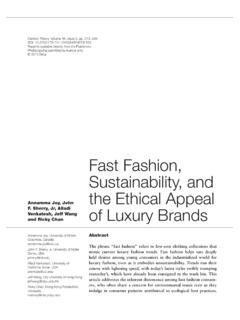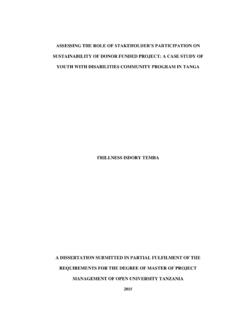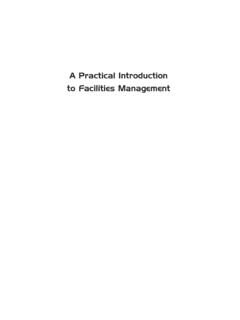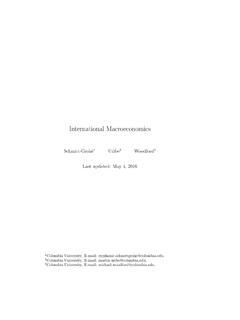Transcription of Foreign aid, economic growth and efficiency development …
1 Foreign aid, economic growth and efficiency development A Data Envelopment Analysis approach Ann Veiderpass Per- ke Andersson SADEV REPORT 2007:01 Swedish Agency for development Evaluation P. O. Box 1902, SE-651 19 Karlstad, Sweden SADEV REPORT 2007:1 Foreign aid, economic growth and efficiency development A Data Envelopment Analysis approach Author(s): Ann Veiderpass and Per- ke Andersson Copyright: SADEV SADEV Reports are available at Printed in Karlstad, Sweden 2007 ISSN 164-045X ISBN 978-91-85679-04-1 Foreign AID, economic growth AND efficiency development PREFACE Preface The Swedish Agency for development Evaluation (SADEV) is a government-funded institute that conducts and disseminates evaluations of international development cooperation.
2 SADEV s overall objective is to increase the efficiency of Swedish devel-opment cooperation. SADEV has two main areas of work. The first is the organization of international development cooperation focusing on issues such as management and monitoring of executive organisations, donor coordination, and the internal efficiency of donor organisations. The second area is concerned with the short- and long-term impact of development assistance on the well being of partner country populations.
3 SADEV evaluations are published as reports and studies. Interim or pre-studies are circulated as working papers. This SADEV Report is part of the wider project theme: Foreign aid, economic growth and efficiency development , and is the first of a series of studies investigating aid effectiveness in a production theory context. One purpose of the report is to investigate whether Foreign aid improves the efficiency of resource use in a country in the short term. Another is to investigate the feasibility of using the specific production theory context when examining aid effectiveness.
4 This should be seen as the first step towards find-ing a method for policy makers to assess the overall impact of aid on development in a partner country. Such methods are of increasing importance in an era of increased ownership according to the Paris Declaration and increased use of budget support. October, 2007 Lennart Wohlgemuth Acting Director General i Foreign AID, economic growth AND efficiency development ABSTRACT Abstract This study attempts to add a piece to the aid effectiveness puzzle by evaluating aid effectiveness in a production theory context.
5 The first step is to establish how well a country is using its resources. This is measured by means of an efficiency index which reflects the production ability of a country. The second step is to examine whether we can find any systematic correlation between the efficiency of a country and resource inflow in the form of aid. The study covers the performance of 60 countries between 1995 and 2000. China, followed by Nigeria, displays the highest relative efficiency values over the period of study.
6 The lowest efficiency , between 14 and 15 per cent each year between 1995 and 2000, is found in India, Indonesia and Pakistan. We also find that labour and energy intensive countries generally display lower efficiency scores in relation to less labour and energy intensive countries while we find indications of a positive relation between capital intensity and country efficiency . When linking country efficiency development to aid, there is no clear pattern to be found. This fact clearly points to the value of a continued study covering a substan-tially longer period of time, a more extensive data set and perhaps also the inclusion of different aid measures.
7 Ii Foreign AID, economic growth AND efficiency development CONTENTS Contents 1 Executive 2 3 Aid 4 Measuring 5 Data and model 6 Empirical 7 Concluding Appendix Appendix Appendix Appendix iii Foreign AID, economic growth AND efficiency development EXECUTIVE SUMMARY 1 Executive summary The question whether or not Foreign aid enhances economic growth and efficiency in resource use has long been debated, but still no consensus is found among research-ers and policy makers.
8 In spite of numerous studies, there is little evidence of a significant positive effect of aid on the long-term growth of poor countries. Politically important results showing that aid works better when policy environment is condu-cive to growth have proven not to hold when data is expanded and/or new variables added. This study attempts to add a piece to the aid effectiveness puzzle by evaluating aid effectiveness in a production theory context. The first step is then to establish how well a country is using its resources.
9 This is measured by means of an efficiency index which reflects the production ability of a country. The second step is to examine whether we can find any systematic correlation between the efficiency of a country and resource inflow in the form of aid. Energy, labour and capital are the resources (inputs) traditionally considered in pro-duction models, while GDP may be regarded as the output produced in the produc-tion process of a country. Increased GDP growth is considered to be the objective of the 60 countries included in this study.
10 The countries belong to five different geo-graphical categories: Sub-Saharan Africa, East Africa and the Pacific, Latin America and the Caribbean, Middle East and North Africa and South Asia. Input and output data were obtained for each country each year between 1995 and 2000. The efficiency concept used (obtained through the Data Envelopment Analysis, DEA, method), tells us how successful different countries are when producing GDP. This is a relative measure of efficiency , and the efficiency of a country is thus measured relative to the efficiency of all the other countries.

















